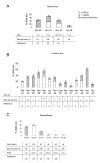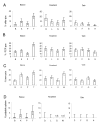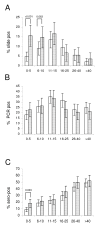Comparison of surveillance methods applied to a situation of low malaria prevalence at rural sites in The Gambia and Guinea Bissau
- PMID: 19954532
- PMCID: PMC2791766
- DOI: 10.1186/1475-2875-8-274
Comparison of surveillance methods applied to a situation of low malaria prevalence at rural sites in The Gambia and Guinea Bissau
Abstract
Background: Health record-based observations from several parts of Africa indicate a major decline in malaria, but up-to-date information on parasite prevalence in West-Africa is sparse. This study aims to provide parasite prevalence data from three sites in the Gambia and Guinea Bissau, respectively, and compares the usefulness of PCR, rapid diagnostic tests (RDT), serology and slide-microscopy for surveillance.
Methods: Cross-sectional surveys in 12 villages at three rural sites were carried out in the Gambia and Guinea Bissau in January/February 2008, shortly following the annual transmission season.
Results: A surprisingly low microscopically detectable parasite prevalence was detected in the Gambia (Farafenni: 10.9%, CI95%: 8.7-13.1%; Basse: 9.0%, CI95%: 7.2-10.8%), and Guinea Bissau (Caio: 4%, CI95%: 2.6-5.4%), with low parasite densities (geometric mean: 104 parasites/microl, CI95%: 76-143/microl). In comparison, PCR detected a more than three times higher proportion of parasite carriers, indicating its usefulness to sensitively identify foci where malaria declines, whereas the RDT had very low sensitivity. Estimates of force of infection using age sero-conversion rates were equivalent to an EIR of approximately 1 infectious bite/person/year, significantly less than previous estimates. The sero-prevalence profiles suggest a gradual decline of malaria transmission, confirming their usefulness in providing information on longer term trends of transmission. A greater variability in parasite prevalence among villages within a site than between sites was observed with all methods. The fact that serology equally captured the inter-village variability, indicates that the observed heterogeneity represents a stable pattern.
Conclusion: PCR and serology may be used as complementary tools to survey malaria in areas of declining malaria prevalence such as the Gambia and Guinea Bissau.
Figures





Similar articles
-
Dry season prevalence of Plasmodium falciparum in asymptomatic gambian children, with a comparative evaluation of diagnostic methods.Malar J. 2022 Jun 7;21(1):171. doi: 10.1186/s12936-022-04184-9. Malar J. 2022. PMID: 35672850 Free PMC article.
-
A large proportion of asymptomatic Plasmodium infections with low and sub-microscopic parasite densities in the low transmission setting of Temotu Province, Solomon Islands: challenges for malaria diagnostics in an elimination setting.Malar J. 2010 Sep 7;9:254. doi: 10.1186/1475-2875-9-254. Malar J. 2010. PMID: 20822506 Free PMC article.
-
Field performance of the malaria highly sensitive rapid diagnostic test in a setting of varying malaria transmission.Malar J. 2019 Aug 27;18(1):288. doi: 10.1186/s12936-019-2929-1. Malar J. 2019. PMID: 31455349 Free PMC article.
-
Assessing the burden of submicroscopic Plasmodium infections in a pre-elimination malaria setting in sub-Saharan Africa, Guinea-Bissau.Malar J. 2024 Oct 19;23(1):316. doi: 10.1186/s12936-024-05138-z. Malar J. 2024. PMID: 39427159 Free PMC article.
-
Health & Demographic Surveillance System Profile: Farafenni Health and Demographic Surveillance System in The Gambia.Int J Epidemiol. 2015 Jun;44(3):837-47. doi: 10.1093/ije/dyv049. Epub 2015 May 6. Int J Epidemiol. 2015. PMID: 25948661 Review.
Cited by
-
Prevalence of community-acquired bacteraemia in Guinea-Bissau: an observational study.BMC Infect Dis. 2014 Dec 20;14:3859. doi: 10.1186/s12879-014-0715-9. BMC Infect Dis. 2014. PMID: 25526763 Free PMC article.
-
Accuracy of One Step malaria rapid diagnostic test (RDT) in detecting Plasmodium falciparum placental malaria infection in women living in Yaoundé, Cameroon.Malar J. 2018 Dec 4;17(1):450. doi: 10.1186/s12936-018-2595-8. Malar J. 2018. PMID: 30514316 Free PMC article.
-
The breadth, but not the magnitude, of circulating memory B cell responses to P. falciparum increases with age/exposure in an area of low transmission.PLoS One. 2011;6(10):e25582. doi: 10.1371/journal.pone.0025582. Epub 2011 Oct 4. PLoS One. 2011. PMID: 21991321 Free PMC article.
-
Malaria parasite density and detailed qualitative microscopy enhances large-scale profiling of infection endemicity in Nigeria.Sci Rep. 2023 Jan 28;13(1):1599. doi: 10.1038/s41598-023-27535-1. Sci Rep. 2023. PMID: 36709336 Free PMC article.
-
School-based countrywide seroprevalence survey reveals spatial heterogeneity in malaria transmission in the Gambia.PLoS One. 2014 Oct 22;9(10):e110926. doi: 10.1371/journal.pone.0110926. eCollection 2014. PLoS One. 2014. PMID: 25338083 Free PMC article.
References
-
- Ceesay SJ, Casals-Pascual C, Erskine J, Anya SE, Duah NO, Fulford AJ, Sesay SS, Abubakar I, Dunyo S, Sey O, Palmer A, Fofana M, Corrah T, Bojang KA, Whittle HC, Greenwood BM, Conway DJ. Changes in malaria indices between 1999 and 2007 in The Gambia: a retrospective analysis. Lancet. 2008;372:1545–1554. doi: 10.1016/S0140-6736(08)61654-2. - DOI - PMC - PubMed
-
- Nyarango PM, Gebremeskel T, Mebrahtu G, Mufunda J, Abdulmumini U, Ogbamariam A, Kosia A, Gebremichael A, Gunawardena D, Ghebrat Y, Okbaldet Y. A steep decline of malaria morbidity and mortality trends in Eritrea between 2000 and 2004: the effect of combination of control methods. Malar J. 2006;5:33. doi: 10.1186/1475-2875-5-33. - DOI - PMC - PubMed
Publication types
MeSH terms
Grants and funding
LinkOut - more resources
Full Text Sources

